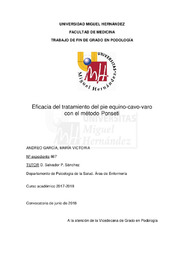Por favor, use este identificador para citar o enlazar este ítem:
https://hdl.handle.net/11000/25912Registro completo de metadatos
| Campo DC | Valor | Lengua/Idioma |
|---|---|---|
| dc.contributor.advisor | Sánchez Pérez, Salvador Pedro | - |
| dc.contributor.author | Andreo García, María Victoria | - |
| dc.contributor.other | Departamentos de la UMH::Psicología de la Salud | es_ES |
| dc.date.accessioned | 2022-02-21T09:41:03Z | - |
| dc.date.available | 2022-02-21T09:41:03Z | - |
| dc.date.created | 2018-06-20 | - |
| dc.identifier.uri | http://hdl.handle.net/11000/25912 | - |
| dc.description.abstract | Introducción: El pie equino varo, conocido también como pie zambo, es una de las anormalidades musculoesqueléticas más comunes en la infancia. La deformidad tiene cuatro componentes básicos: cavo, aducto, varo y equino. Esta deformidad ocurre en el periodo de maduración o fetal, es de causa idiopática y se desarrolla en el segundo trimestre de embarazo. Puede diagnosticarse en la semana 20 del embarazo mediante ecografía. El tratamiento inicial de estos pies debe ser no quirúrgico y comenzar poco después del nacimiento. Se realiza con técnicas conservadoras combinadas con escayolas, tenotomía aquilea, férulas de abducción y fisioterapia antes de que la deformidad quede instaurada. Objetivos: Evaluar la eficacia del método Ponseti, y describir las recidivas y complicaciones del tratamiento del pie equino varo mediante este método. Material y métodos: Se ha llevado a cabo una búsqueda bibliográfica en las bases de datos Pubmed y Science Direct para averiguar la eficacia y complicaciones del método Ponseti en el tratamiento del pie zambo. Resultados: De esta revisión se ha podido caracterizar el porcentaje de curación del pie equino varo utilizando el método Ponseti, y el porcentaje de persistencia de la deformidad tras aplicar el tratamiento con este mismo método. Discusión: Tras analizar los estudios expuestos en nuestros resultados comprobamos que se obtiene una alta tasa de curación y baja tasa de persistencia. Conclusiones: El pie equino varo es una malformación que se presenta en el recién nacido. El método Ponseti es el tratamiento aceptado como la mejor opción para este tipo de pies. Las complicaciones más frecuentes se derivan de la falta de seguimiento del método de tratamiento. | es_ES |
| dc.description.abstract | Introduction: Talipes equinovarus, also known as clubfoot, is one of the most common musculoskeletal abnormalities in childhood. The deformity has four basic components: cavo, adduct, varus and equine. This deformity occurs in the period of maturation or fetal, is of idiopathic cause and it develops in the second trimester of pregnancy. It can be diagnosed in the 20th pregnancy week by using ultrasound. Initial treatment should be non-surgical and begin shortly after birth. It is performed with conservative techniques combined with plaster, tenotomy aquilea, abduction and physiotherapy splints before the deformity become permanent. Aims: To evaluate the effectiveness of the Ponseti Method, and to describe the recurrences and complications of Equine varus foot treatment using this method. Material and methods: A bibliographic search was carried out in the databases Pubmed and Science Direct to find out the efficacy and complications of the Ponseti method in the treatment of clubfoot. Results: It´s possible to characterize the percentage of healing of the equine foot varus using the Ponseti method, and the percentage of the persistence of the deformity after applying the treatment with this method. Discussion: After analysing the studies exposed and it´s results, It has been possible to verify that it obtains a high cure rate and low persistence rate as well. Conclusions: Tapiles equinovarus is a malformation that occurs in the newborn. The Ponseti method is the accepted treatment as the best option for this type of malformation. The most frequent complications stem from the lack of follow-up of the treatment method. | es_ES |
| dc.format | application/pdf | es_ES |
| dc.format.extent | 32 | es_ES |
| dc.language.iso | spa | es_ES |
| dc.publisher | Universidad Miguel Hernández | es_ES |
| dc.rights | info:eu-repo/semantics/openAccess | es_ES |
| dc.rights | Attribution-NonCommercial-NoDerivatives 4.0 Internacional | * |
| dc.rights.uri | http://creativecommons.org/licenses/by-nc-nd/4.0/ | * |
| dc.subject | pie zambo | es_ES |
| dc.subject | método Ponseti | es_ES |
| dc.subject | trastornos congénitos | es_ES |
| dc.subject | pediatría | es_ES |
| dc.subject | férula | es_ES |
| dc.subject.other | CDU::6 - Ciencias aplicadas | es_ES |
| dc.title | Eficacia del tratamiento del pie equino-cavo-varo con el método Ponseti | es_ES |
| dc.type | info:eu-repo/semantics/bachelorThesis | es_ES |

Ver/Abrir:
867_ANDREO_GARCIA_MARIA_VICTORIA.pdf
623,38 kB
Adobe PDF
Compartir:
 La licencia se describe como: Atribución-NonComercial-NoDerivada 4.0 Internacional.
La licencia se describe como: Atribución-NonComercial-NoDerivada 4.0 Internacional.
.png)